Looking for a good, usable hatchet? Check out this Huron.
by Leon Pantenburg
BARCO industries supplied the product used in this review. I was not paid to write this, and at the time of publication, there is no sponsorship relationship between the company and Survivalcommonsense.com.
“A woodsman should carry a hatchet, and he should be as critical in selecting it as in buying a gun. The notion that a heavy hunting knife can do the work of a hatchet is a delusion. When it comes to cleaving carcasses, chopping kindling, blazing thick-barked trees, driving tent pegs or trap stakes, and keeping up a bivouac fire, the knife never was made that will compare with a good tomahawk. The common hatchets of the hardware stores are unfit for a woodsman’s use. They have broad blades with beveled edge, and they are generally made of poor, brittle stuff. A camper’s hatchet should have the edge and temper of a good axe. It must be light enough to carry in one’s knapsack, yet it should bite deep in timber.” – Horace Kephart, from Camping and Woodcraft, 1917
I moved to Mississippi in the early 1980s, to a house that was 90-percent heated with wood. I helped cut several cords of firewood every fall, and loved it. I learned to fell trees, use a chainsaw and split wood. We used axes and hatchets, and knowing how to sharpen them was part of the skill set. Like anything, having the right tools, properly maintained, made all the difference.
But I’m lukewarm on recommending that anyone get an axe or hatchet.
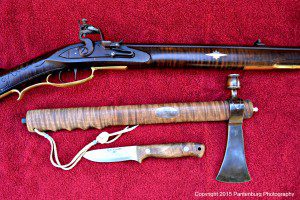
My squirrel hunting gear includes a handmade pipe tomahawk.
The hatchet, or hand axe, has been around since somebody tied a rock to a stick and made a weapon. The hand axe was popular with the Vikings and other fighters in the Middle Ages, because it was a fearsome weapon, and cheaper to make than a sword. In North America, the natives carried tomahawks as weapons.
Today, I don’t carry a hatchet much, but I have several that are used as needed. I carry my pipe tomahawk the most, and that is generally when I’m hunting with a blackpowder rifle. It’s more for nostalgia than anything else.
My most recent acquisition is a Huron 13-inch Half Hatchet. Forged in the USA by BARCO Industries, each hatchet gets profiled, sharpened and finished in Michigan. The 13-inch hickory handle on the Huron is flame-treated, then finished with Linseed Oil and the head is outfit with a handmade, holster-style sheath.
Specifications
- Head Type: 1.25 lbs Half Hatchet pattern pattern
- Head Material: 1060-1078 grade alloy steel
- Shaping Process: Open faced die drop forged
- Bit (Edge): Tempered to final hardness of Rc 50
- Handle Material: American Hickory; Grade A
- Hang: Wood wedge with juxtaposed steel wedge
- Overall Weight: 2 lbs.
- Sheath Material: 100% top grade leather, Antique Brass hardware
Here’s the good stuff:
Steel: A softer steel is the best choice in a hatchet head. A soft steel will bend, rather than chip, when it hits something hard. It is also easier to sharpen, and maintain a good edge. While the Huron could be honed to shaving sharpness, that edge wouldn’t last long when chopping wood. For chopping and splitting firewood, the Huron holds an edge nicely, and is easily re-sharpened.
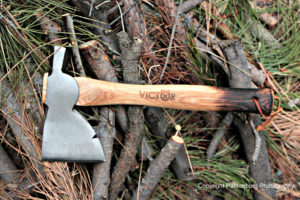
Huron 13-inch Half Hatchet
The 1060 carbon steel in the head, with a RC of 50, is a good hardness for a hatchet. It is hard enough to hold and edge, but soft enough that the steel will fold over, rather than chip, if a knot or hard piece is hit.
Head style: Among my hatchet collection is a modern Estwing double-bitted, a Plumb carpenter’s axe, an Estwing Sportsman and a custom, handmade pipe tomahawk that matches my flintlock rifle. I also have a full-sized axe that sees use in camp.
My most-carried hatchet is the pipe tomahawk, but the most useful pattern is the half-hatchet pattern. The hammer side will be the most used part of the hatchet, because it will be used for driving tent stakes, pounding on things and a multitude of hammer tasks.
Handle: “In making a new axe-helve, do not bother to make a crooked one like the store pattern. Thousands of expert axe men use, from preference, straight handles in their axes,” – Horace Kephart.
I haven’t used a hatchet as much as I’ve used a 22-ounce framing hammer. Roughly of the same weight as the Huron, I’ve swung a hammer for hours at a time while roofing and putting on siding. (One reason I have large hands!) A straight handle works best for me, as far as being able to control the head. Like anything, get used to the weight and balance, and real accuracy soon develops.
It’s the same concept with a hatchet. A hatchet cuts with momentum and velocity, and you will develop efficiency through use.
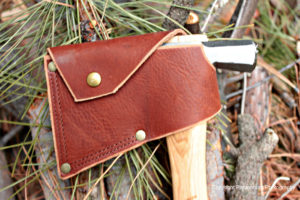
The Huron’s leather sheath protects the edge and the user.
Weight: At two pounds, the hatchet is not so heavy as to be overly burdensome. It is in the same ballpark as a heavy duty machete or parang. In jungle or swamp, the long knife may prove to be more useful. In hardwood, deciduous timber, the hatchet will prove to be more useful.
Edge: The grind on the blade appears to be convex. This is a good profile for a chopper, and the the extra steel behind the edge means it will be strong.
Sheath: The leather sheath is handmade by the Victor company and it makes the hatchet easy to carry and safe. It protects the edge and the user.
Finish: The Victor Company also does all the finish work on the hatchet, and that makes it look good and feel comfortable to use.
Not so hot on:
Leon mounts the soapbox: The Boy scouts have banned hatchets, and some troops and camps ban sheath knives. Ostentatiously, it is because the tools are presumed to be dangerous. Well, ANY cutting tool is dangerous in the hands of an untrained person.
The scouts make a big deal about teaching knife and axe safety, and every scout must carry a Totin’ Chip before carrying any piece of cutlery. If the scouts can’t teach cutting tool safety, to the point where certain categories of tools must be deemed unsafe, then what is wrong with the program? (Leon’s rant is over).
Do you need a Huron hatchet?
Well, I think to the untrained user a hatchet or axe is dangerous. Don’t buy one to add to your camping gear, and never practice with it.
A hatchet or axe requires velocity to chop and cut, and one can cause serious injury if it ricochets off the wood. A better choice, for the casual user, would be to get a good saw, and use that for wood processing.
If you know what you’re doing, a hatchet and/or axe can be a valuable survival tool. So if you decide to go that route, get a good one.
The Huron is a quality tool, and at $110, it is priced competitively with other high quality hatchets. The Huron will prove to be an investment, and properly cared for, it can be handed down to your grandchildren.
Please click here to check out and subscribe to the SurvivalCommonSense.com YouTube channel, and here to subscribe to our weekly email update – thanks!

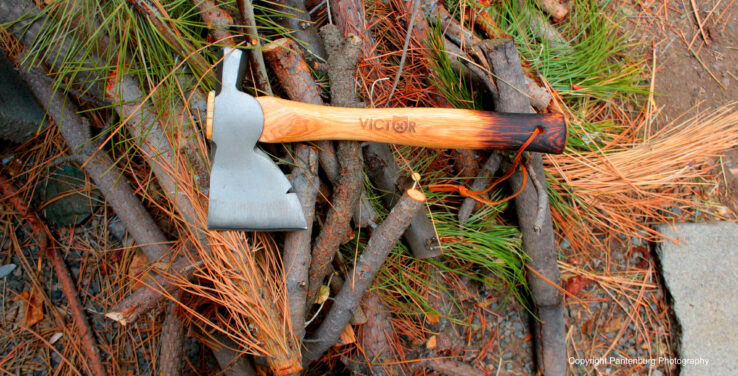


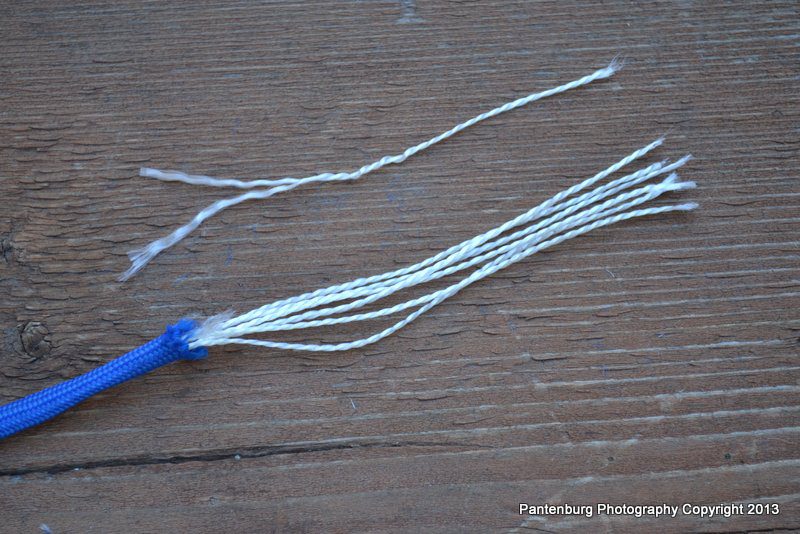
Leave a Reply